Good
to Know
We know that you care about the well-being of your pets. That’s why we invite you to learn about several topics of interest that will help you understand their needs.
Happy reading!
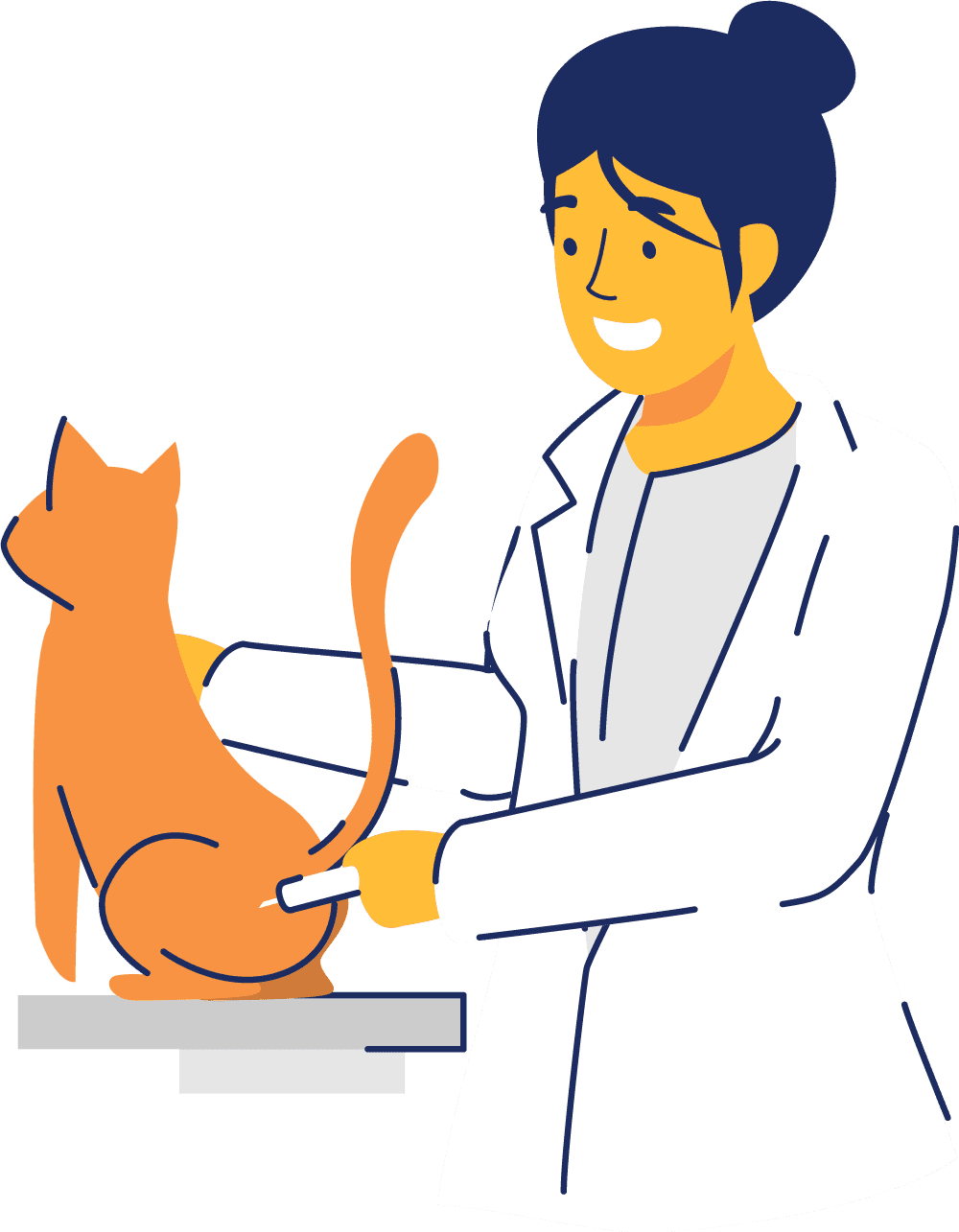
Insurance
DID YOU KNOW THAT …
- 75 %* of all dogs and cats will suffer from an illness or injury at some point in their life?
- One in three pets will need emergency veterinary care each year?
- There are health and accident insurance for your dog and cat?
- In Quebec, very few people have insurance while in Sweden or Great Britain, half of pet owners have one?
* Source American Veterinary Medical Association
For example, dogs and cats will need descaling in their lifetime and this can result in high costs. And what happens when an injury or a genetic defect needs to be corrected? Even the most forward-thinking owners can be taken aback by costly veterinary bills.
That’s why various insurance programs exist. Depending on your coverage, you may be reimbursed for vaccines, drugs, surgeries, dental care, and even therapeutic treatments such as physiotherapy. Pet insurance might save you from having to euthanize your companion.
Before purchasing pet insurance, compare the different packages offered (coverage, deductible, and monthly payment) and choose according to your needs and budget. The costs also depend on certain criteria such as age or breed. You can take out insurance even if your dog or cat is old, but in this case, certain health conditions will be excluded. Costs range from approximately $15 to $55 a month. Some companies even offer a free trial period.
To know more:
Alternatives to declawing
DID YOU KNOW …
- Cats make their claws to mark their territory, stretch their back and sharpen their claws?
- The risks of injury are lower when children have learned to recognize the cat’s body language?
- Cats need places to « have peace »?
- The younger we trim a cat’s claws, the faster the cat gets used to it?
For the cat, making its claws is normal behaviour which allows it to mark its territory from both an olfactory and visual point of view. It also allows him to stretch his back and maintain his claws.
Declawing is not necessary for the health of cats; there are alternatives.
Education
Cats with no claws can develop more behavioural problems. Some may start to poop outside the litter box or bite to defend themselves. Ghost pain or lameness has also been reported in patients.
Teaching children to recognize and respect the cat’s body language reduces the risk of injury. A cat that cannot use its claws to defend itself will more quickly resort to biting. A large cat bite can cause more injury than a scratch.
A cat that flattens its ears back, rumbles, whispers or whips its tail wants to be left alone. The cat needs a place to have peace. By clearly establishing these places with the children, the kitty will be able to take refuge there and not be disturbed.
Claw post (scratching post)
In the wild, cats make their claws on trees. It is important that home posts also called scratching posts, have the same characteristics, that is, stability, height, texture and location. Several prefabricated models found in stores do NOT meet these criteria. Make sure you properly choose your cat’s scratching post.
Stability – The structure must not move when the cat jumps on it. If your scratching post does not have the necessary stability, attach it to the floor, wall or furniture.
Height – The scratching post must be at least 36 inches high so that your cat can stretch his back completely.
Texture – The scratching post should be covered with materials that cats like, such as carpet, rope or cardboard. Each kitty has its material preferences.
Location – For kitty to like using it, you must place the scratching post in the middle of the cat’s territory. It must be at the entrance to the rooms and close to the furniture that could otherwise be considered by kitty.
Tips to end scratching
- Direct your cat’s scratches to a scratching post by applying Feliscratch (by FeliwayR)
- Give your cat time to learn this behavior.
Feliscratch works in 3 ways:
- The blue lines of the product imitate the visual marks left by the cat’s claws.
- Catnip helps attract the cat to the scratching post.
- Pheromones serve as messengers telling the cat to claw where Feliscratch has been applied.
Claw size
It is important to cut the claws regularly to avoid injury and reduce damage to the furniture. It will be easier to do this if kitty has been used to this procedure at a young age and with positive reinforcement. A good frequency for claw size would be every 4 weeks.
For more information on the size of claws, ask the staff of Passion Compassion Veterinary Hospital.
Claw covers
Small claw covers can also be put on each of the claws to avoid damage to the furniture. They are easily installed with special glue. Most cats accept them without problem. They are available in several sizes and colors to satisfy all tastes. The claw covers are designed to stay in place for four to six weeks.
Move
DID YOU KNOW …
- The moving season can be a great source of stress for our animals?
- Certain undesirable behaviors can resurface?
Here are a few tips to help your four-legged pet experience this change:
- Do NOT wash their personal belongings before the move (blanket, cushion) so that the reassuring smell of the house is present on their preferred items.
- For dogs, if you can, go explore the new property before the madness of the move.
- For cats, it is preferable to lock them in a room with all their personal effects (food, litter, blanket) during the first days in their new environment, this will help them to adapt more quickly.
- Certain products can help your pet to calm down in its new environment: Adaptil (dog) and Feliway (cat). These two products release pheromones, known for their calming effect. Bitches and lactating cats naturally release it which helps their babies to calm down and promotes self-confidence.
- Adaptil is available as a necklace, spray and diffuser.
- Feliway is available in spray and diffuser.
- However, we recommend the use of a diffuser for the move. This will release the pheromones for a month, which is the average time for an animal to acclimatize to its new environment.
- For those who are more difficult to transport (nausea, vomiting) or those who have anxiety (panting or excessive barking), there are drugs to help your pet make the journey without any inconvenience (Cerenia and Trazodone).
Be forgiving with your pets, moving can be stressful for them. And don’t worry, everything will return to normal, be patient!
Education
DID YOU KNOW …
- 32% of Quebec households have a cat?
- 24% of Quebec households have a dog?
- More than half of cat owners said they avoid taking their pet to the vet due to transportation stress.
How to choose your animal according to his lifestyle?
Cats and dogs are appreciated in Quebec, and with good reason! They keep us company, they give us affection, they make us happy and in a good mood. Although it is tempting to integrate one of its furry into our family, choosing to adopt a pet is not a decision to be taken lightly. This love ball also generates responsibilities, time, costs, and care. Knowing that in Quebec, one pet in four is abandoned every day, several elements must be considered in order to make a wise choice, consistent with his lifestyle.
The right animal for my lifestyle
Are you a student, worker, retiree? Do you live alone, as a couple, with children? Do you live in a house, a condo, an apartment? Are you an active person or not? How much free time do you have? Is this your first animal? Do you have other animals? It is essential to question your lifestyle in order to choose an animal that suits you. You will find here * an example of a questionnaire to complete before making your decision.
Remember that a discordant choice will have repercussions on you, your entourage, and especially on your new companion! Animal health professionals are trained to guide you in the appropriate choice of your new animal, so do not hesitate to contact us to use our expertise.
Costs
Before making the decision to adopt a cat or a dog, it is important to consider the costs involved. Adoption, food, veterinary care (exam, vaccines, dewormers, etc.), sterilization, microchip, accessories are all costs to be considered when taking care of an animal. Take the time to calculate them and check if they fit into your budget. In the « Public » tab of the website of the Association of Veterinary Physicians of Quebec, you will find articles detailing the costs according to the species and age of your animal. Also, several companies now offer insurance for your faithful companions.
Good To know:
- Each animal is unique, hence the importance of meeting it before adopting it.
- Once sterilized, the characteristics of the two sexes are quite similar.
- An adult animal is generally less expensive than a baby animal, since it is already sterilized, has received its first vaccines/dewormers and is no longer growing.
- The temperament of an adult animal is already known, versus that of a younger one who is mouldable.
- Racy cats, especially oriental ones, need a lot of attention. These are cats who need to work out and who require more investment.
- A purebred cat is more expensive than a domestic cat, considering the cost to purchase. The same is true for a purebred dog.
- There is a wide variety of dog breeds, each with very different needs. Take the time to learn about the characteristics of the breed you are interested in to be sure that it suits your lifestyle.
- An indoor cat needs to be stimulated. An outdoor cat needs to be protected (vaccines, dewormers) and is exposed to more risks (cars, fights, wild animals, parasites, etc.).
- A puppy needs to be educated and socialized (for example, through kindergarten lessons). Patience and time are required.
Questions to ask yourself before adopting an animal
- Why do you want to have a dog / cat?
- Is this your first dog / cat? Your first animal?
- If you have had a dog / cat before, how long have you had it? What race? Why don’t you have it anymore?
- Do you have other pets at home? If yes, specify.
- Do you live with your family, as a couple, roommate or alone?
- (If alone or as a couple) – Do you envisage children for the future?
- (If with family) How many children do you have?
- (If with family) How old are they?
- Age of client and gender
- What type of accommodation do you live in?
- Do you have a yard? How big?
- Do you have access to a nearby park or dog park?
- Do you have any health problems that could interfere with your adoption plans? And your loved ones? (Allergies, for example)
- What job do you have? Is it very demanding?
- How often are you at home?
- How long would you leave your pet alone at home?
- Do you regularly go outside for work or vacation?
- If yes, would you and would it be possible to travel with your pet?
- (If he is alone) Is there someone who can help you out if something unexpected happens, who can come to take care of the dog / cat?
- How long would you be willing to allocate to your pet daily?
- Do you have an idea of the daily, weekly, yearly cost of a dog / cat? How much are you ready to invest?
- Would you be ready to adopt a breed of dog / cat whose life expectancy is a little shorter than the average? A little longer?
- Are you ready to invest if your pet has health problems? If yes, do you have a limit?
- Are there people around you who are afraid of dogs / cats? Who have had bad experiences with a dog / cat?
- If yes, are they afraid of a particular breed or size?
- Tell us about yourself. What kind of person are you? What qualities do you have that you think can be useful when adopting an animal? (Patience, leadership, confidence, good humor, credibility, fit, gentleness and authority, intuition, etc.)
- Are you an active person?
- If yes, what kinds of activities do you do?
- Do you want to do activities and / or competitions with your pet? If yes, what kind of activities?
- Do have preferences for certain dog / cat breeds?
- Are there any dog / cat breeds that you absolutely do not want to have as a companion?
- Are there breeds that you dislike? That you worry about?
- What qualities do you look for in an animal?
- What temperament would you prefer for your pet?
- What kind of relationship do you want with your pet?
- Is there a size of dog / cat that you would prefer?
- Do you want a more active or quieter animal?
- Do you want an animal with a more dependent or independent nature?
- Do you want an indoor or outdoor pet?
- Do you want your pet to poop inside (pee-pad / litter) or outside?
- Do you want an animal whose education can be a challenge or rather an animal that trains easily?
- Would you be willing to shell out money for kindergarten and education for your dog?
- Do you have a barking tolerance?
- Are you comfortable leaving a dog in a cage?
- Do you have a preference between a male or a female animal?
- Do you have a preference between:
- Long hair, short hair, curly hair, rough or hairless hair?
- Small legs, medium legs or long legs?
- Hanging, semi-hanging or raised ears?
- Large or elongated skull?
- Long, short, turned, stump or absent tail?
- Waist slimmer or chunkier?
- Big lips or not?
- Would you be interested in adopting in a shelter?
- Do you have some knowledge of the basic care of a dog / cat such as:
- Claw size?
- Brushing / hair care?
- Teeth brushing?
- Ear cleaning?
- Eye cleansing?
- Food?
- Registration / Identification?
- Toys?
How to introduce a new animal into our environment?
It’s time for your companion to come home! So that the introduction goes smoothly and without problems, here are some tips for you:
- Make sure the house is ready to welcome your cat or dog (food, accessories, toys, etc.) before his arrival. In addition, check that your environment is safe (no toxic plants, dangerous hiding places, toxic products, etc.)
- Make sure you are present the days after your arrival. It is ideal to host it on weekends, so you can be sure that everything is going well!
- Remember that your pet is entering a whole new environment. Stay calm and listen to their needs. Some animals will be more fearful, and others will be comfortable very quickly.
- To reduce the stress of arrival, certain products in wall diffuser or spray, such as Adaptive (canine) and Feliway (feline), can be used.
- Always use the positive reinforcement method! If the animal acts correctly, reinforce its good behavior with rewards.
- If you are introducing a new dog, make sure that the cage is present from the first day and that is attractive. Put a blanket, some toys and treats on it. Get him used to going there during the day and use positive reinforcement so that bedtime is easier, and the cage becomes a reassuring place.
If there are other animals already living in your home, certain steps are important to ensure that the introduction goes smoothly.
First, you should know that your animals can transmit diseases to each other. It is therefore important that the animals already present in your home are well protected (vaccines, dewormers), and that your new animal be seen quickly by a veterinarian before they are in contact.
Then prepare a transition room for the newcomer. This place should be pleasant and provided with everything the animal needs (food, water, accessories, toys, etc.) The latter can be installed in this furnished room for a period of a few days, so that all the animals in the house get used to the new individual.
Once this contactless period has ended, you can, for periods of a few hours, swap roles, that is, install the resident animals in the transition room, and the new animal in the house, at large. Thus, the smells will mix, and the transition will be less stressful for all. Do not hesitate to use treats.
When all the animals are calm (can take a few days) during the exchanges, you can proceed to the official meeting. On the Educhateur web site, this introduction is very detailed, and a video was even made: https://educhateur.com/introduire-nouveau-chat/
The key is to foster positive interactions between animals through treats, games, time, and patience. Make sure that each animal has its food and water, as well as its cat litter (number of litters = number of cats +1).
However, if any questions remain unanswered regarding the arrival of your pet, please do not hesitate to contact us, we will be happy to assist you.
What is the energetic expense for my animal?
Our cats and dogs need exercise. Every day, our animals have energy that they must dissipate, and it is better to occupy them adequately, otherwise bad behavior can appear. Our animals must therefore be stimulated via models of physical, mental, and masticatory activities.
To use these three models, we strongly advise you to feed your animals via interactive toys rather than via conventional bowls, which are now very outdated and inappropriate. Through his « toys », cats and dogs must move, think, and work to get their food. Here are various models that we appreciate and suggest to you.
FELINE:
- SlimCat: Interactive ball-shaped toy that distributes food when the cat rolls it. It allows you to control the portion that your cat receives while making him exercise.
- Wobbler Kong toy: Food or candy dispenser in the shape of the classic Kong toy. It is the ideal accessory for slowly distributing food to your cat, extending the duration of meals so that your cat eats calmly and feels full.
- Cat IT puzzles, labyrinth, or tubes: Interactive toy of various forms which makes it possible to make the cat work mentally to obtain its kibbles and to slow down the flow of ingestion.
- IntelliKat: Interactive bowl with 500 possible variations. A superb challenge for lit and intelligent cats. This toy is specifically designed to stimulate and increase the intellectual demand of your animal while rewarding it.
CANINE:
- Orbee-Tuff: This bowl is a canine puzzle. The dog must push, lick, chew to get the contents out. It is not a toy designed to chew.
- Classic KONG: There are several formats and different strength (puppy, senior, regular and for destructor). It promotes the chewing effect. We like to fil lit with cane food. You can also freeze it to add a level of difficulty.
- Enrichment Mat: Encourages dogs to use their sense of smell to seek out treats or food. Encourages dogs to eat more slowly. Perfect distraction for dogs that requires attention. A summer version of this mat can be tossing the kibble into the grass outside.
- Tricky Treat ball: Food dispensing ball, perfect for working your dogs during their meals, and slowing down the speed at which they eat.
- Green interactive feeder: Interactive bowl, very resistant, perfect for destructive dogs, the #1 retarder bowl.
To further increase the chewing activity of your dogs, there are also several alternatives to « chew toys » such as:
- Beef hoof: VERY durable and 100% natural treat. It is also very practical since it can be used as a Kong and can be stuffed as desired. You can also freeze it to extend the duration of the pleasure!
- Bully stick: The Bully Stick lasts relatively long (although the time varies for each dog) and above all, it is a very safe product. Its fibrous structure is made up of thousands of small « hairs » that will quietly soften following the dog’s chewing activity. There is therefore virtually no danger of a piece breaking and choking the dog.
- Everest Cheese: Very durable treat made from Yak milk, a Himalayan buffalo. When the stick becomes so small that it can be dangerously swallowed by the dog, put it in the microwave oven for about half a minute. The piece will swell to make a big cheese popcorn that your dog cane at, causing no loss!
- Popsicle Canine version: Very nice alternative to increase chewing activity as well as water intake. Use your imagination to make popsicles that your dog will enjoy. Here are some ideas:
- In a pot of yogurt, a Kong, or a hoof of beef, put a little cane, kibble, and add a little water.
- In a pot of yogurt, put some kibble and add a little sodium-low chicken / beef broth.
- In a silicone mold, dilute cane meat with water.
My pet hates going to the vet, what should I do?
For many animals, including certain dogs, transportation by car and / or a visit to the veterinarian creates a lot of stress. However, there are tips and solutions to remedy this, and to facilitate the journey between your home and our Veterinary Hospital.
- Use a well-ventilated box make of sturdy plastic, fitted with a front door and ideally with a top that can be dismantled.
- Place the open cage in a quiet place where your pet enjoys spending time. Over time, your pet will get used to it and hide there when it wants to be alone. At a minimum, take out the cage several days before the planned trip.
- Place a piece of clothing impregnated with your scent in the cage. Add a fluffy blanket, treats or her favorite toy.
- Gently rub a towel over your pet’s face, then rub it over the cage to give it a familiar odor, or spray synthetic pheromones that reduces stress.
- To reduce the risk of motion sickness, avoid feeding your pet within a few hours of departure.
- Once your pet is in the cage, cover the cage with a towel – this will likely help calm him down.
- During the ride, drive slowly and minimize noise (music, horn, etc.). Rather reassure your animal by talking to it softly.
- In the waiting room, leave the towel on the cage and sit as far away from the dogs as possible (with your cat) or vice versa.
- When you get home (if you have other cats), take a towel, and rub your other cats. Then rub the cat that comes back from the vet – this could reduce conflicts.
In addition, gradually accustom your animal to transport. It is better to make several small trips, without necessarily that they always end at the vet, so that he accommodates himself in the car. If you have long hours of transportation to do, consider taking breaks at least every 3 hours, especially with dogs. Finally, if your pet seems to have motion sickness despite our advice, anti-nausea drugs can be prescribed if necessary.
Remember: regular visits to your veterinarian will prolong the life and improve the well-being or your dog/cat. What’s more, you’ll feel better, just like your four-legged friend!
Community commitments
DID YOU KNOW …
- The population of stray cats and injured and abandoned animals on the South Shore is growing, which can become a major problem?
- Our Hospital’s Catch-Sterilize-Release-Adopt program saved more than 120 stray cats in just four years of operation?
Dr. Marie-Eve and her team are driven by the desire to get involved in the community. Through our non-profit organization Mission Passion Compassion, they offer various services aimed at giving a second chance to abandoned animals and a place to flourish for people interested in working in the animal health field. They manage, among other things, a Catch-Sterilize-Release program for stray cats from the South Shore, an adoption service, an education program for children’s elementary schools, a socialization program for stray animals and internships of observation.
Hygiene
DID YOU KNOW …
- Just as it is the case for humans, the body hygiene of our pets contributes greatly to their health and well-being.
- Q-tips may push debris deeper into the ear canal.
Here are some tips to help you with this task.
Ear cleaning
Here are the steps to follow to ensure safe and effective cleaning.
- Use only products designed to clean animals’ ears.
- Fill the ear canal with cleaner, so that the liquid is visible at the upper end of the ear canal.
- Gently massage the base of the ear for about 30 seconds to break up the wax and debris deeply.
- Gentle wipe off debris and cleaner using cotton or cotton pads.
- If there is a large number of debris from the ear canal, repeat steps 2 to 4 until very little debris is collected.
Shampoo
There are several products on the market designed specifically for animals. Do not hesitate to inquire at Passion Compassion Veterinary Hospital to find out which one is best suited to your animal.
To combat the smell of skunk, for example, you can also use homemade blends. Here is an easy recipe to make:
Skunk odor shampoo
Ingredients:
- 1 liter of 3% peroxide
- ¼ of baking soda
- 1-2 tsp. of dish soap
Mix the ingredients. Thoroughly impregnate the animal’s fur with the solution, leave to act for 5 minutes and rinse with plenty of water.
Repeat if necessary.
For a large dog, add 1 liter of water to cover the animal well.
Diseases transmissible to humans
DID YOU KNOW …
- Not all animals infected with rabies become aggressive? There are 2 forms of clinical presentation, the furious form
(aggressive animals, red eyes, and excessive salivation) and the silent form (amorphous animal without other symptoms)? - There is NO TREATMENT for animals or humans who have been infected with rabies and this FATALITY disease is highly contagious?
- The parasite responsible for cryptosporidiosis causes very severe diarrhea in humans which is easy to confuse with
a viral infection of gastroenteritis? - The parasite Giardiasis can survive from 4 days to 2 months depending on whether it is in the air or in the water?
- The cat is the source of environmental contamination resulting from a protozoan parasite (Toxoplasma gondii)?
Rabies

Rabies is an infectious disease that affects the nervous system of all mammals, including humans.
Among the diseases transmissible to humans, rabies is one of the most serious: it is fatal as soon as symptoms appear.
Effects in humans
The first symptoms of rabies result in:
- Numbness or pain at the bite site
- Fever
- Headaches
- Feeling sick, like when you start a cold.
Then the symptoms progress to general malaise which leads to death.
Effects in animals
In addition to non-specific signs of disease such as decreased appetite,
infected animals exhibit behavioural changes such as:
- Aggressiveness
- A tendency to bite without reason
- Disorientation
- Abatement
- Isolation
The incubation period, the time between contamination of the animal and the onset of symptoms of the disease, generally ranges from 2 weeks to 6 months in domestic animals.
Paralysis and excessive salivation are also commonly seen in infected animals. They can transmit the virus through their saliva up to 10 days before the symptoms of the disease appear. If an animal has symptoms characteristic of rabies, it is important to isolate it to minimize contact with humans and other animals. A veterinary surgeon must then quickly assess the animal.
How is a human infected?
The rabies virus can be transmitted by biting, scratching or other contacts between the saliva of an infected animal and a fresh sore or the mucous membranes of the eyes, nose, or mouth.
Prevention
The simplest way to prevent rabies is to be careful in the presence of unknown animals, whether wild or domestic. Here are some basic rules:
- Consult a veterinarian to vaccinate dogs and cats against rabies and assess the relevance of immunizing any other animal going outside
- Do not let pets roam
- Never approach wild, stray, or unknown animals
- Do not touch a bat, even if it is dead
- Teach children about safe behaviour towards animals and not leave them unattended in the presence of a pet.
Interventions
It is important to follow the procedure in case of contact with an animal suspected of rabies or when a domestic animal comes into contact with a suspected animal.
Raccoon rabies

The raccoon is a very widespread animal in the Quebec territory and its behaviour favours contact with humans. Monitoring and eradication of raccoon rabies are therefore particularly important.
MAPAQ and its partners have therefore implemented an intervention plan to protect animal and public health.
Citizens who see a dead or visibly sick, paralyzed, disoriented or abnormally aggressive raccoon, skunk or fox are invited to communicate this information by calling 1 877 346-6763.
Other types of rabies
Each year, a few cases of other types of animal rabies are identified in Quebec:
- Bat rabies, throughout the territory;
- Arctic fox rabies, in Quebec up-north territories.
Intestinal parasites:
Cryptosporidiosis

Cryptosporidiosis is a disease caused by a protozoan parasite (Cryptosporidium).
Effects in humans
- Symptoms: mild fever, profuse watery diarrhea sometimes mixed with blood, abdominal pain, nausea or vomiting.
- Duration of illness: 3 to 14 days
Effects in animals
- Symptoms in animals result in profuse yellowish watery diarrhea, weight loss and sometimes vomiting.
How are humans infected?
- Through direct contact with animals, their secretions, or excretions, via the fecal-oral route (e.g.: smoking after handling an infected animal).
- By consuming contaminated food (e.g.: consuming vegetables from a garden fertilized with contaminated manure or untreated water).
- Person to person by the fecal-oral route (e.g.: forgetting to wash your hands after changing the diaper of an infected child).
Prevention
- Wash your hands frequently, especially in a daycare.
- Wash hands after handling animals.
- In public swimming pools: take a shower before entering the water, exclude people suffering from diarrhea or incontinence as well as children wearing a diaper and prohibit the consumption of food on site.
- Avoid consuming untreated water (lakes, streams, rivers).
- Wash vegetables from the garden before consuming them.
- Make the parasite inactive by freezing (-22°C for 10 days or more) or by heat (65°C for 2 minutes or more).
Giardiasis
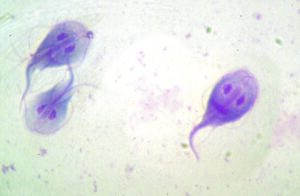
Giardiasis is a disease caused by a protozoan parasite called Giardia.
Effects in humans
- No symptoms are generally seen in healthy people.
- Incubation period: 3 to 25 days, but more often 7 to 10 days.
- Symptoms: diarrhea, stomach cramps, abdominal swelling, and weight loss.
- Duration of the disease: from a few days to a few weeks, with the possibility of recurrence.
Effects in animals
- Symptoms (especially in young animals): diarrhea, depression, bad hair and loss of weight and appetite.
- Infected animals that do not show symptoms can transmit the disease to humans.
How are humans infected?
- Through contact with domestic animals (cattle, horses, pigs, dogs, cats, sheep, and birds) and wild animals (especially the beaver).
- By the environment when there is contamination by excrement (e.g.: waterways, pastures, and gardens).
- By direct contact with a sick person or animal, via the fecal-oral route (e.g.: smoking after treating an infected animal).
- By consuming contaminated food, such as vegetables from a garden fertilized with contaminated manure or untreated water.
Prevention
- Wash your hands with soap and water after changing a child’s diaper or touching an animal, and before handling food or cooking utensils.
- Properly dispose of household waste and feces from animals.
- Analyze well water regularly and avoid drinking untreated water (lakes, streams).
- Restrict access to contaminated places, dry them, wash them well and disinfect them.
- Increase hygiene measures. The parasite responsible for giardiasis is resistant to most disinfectants. The chlorination of drinking water or swimming pool water is not sufficient to destroy it.
Toxoplasmosis

Toxoplasmosis is a disease caused by a protozoan parasite. Most of the time, the infection is symptom-free.
Effects in humans
- Possible symptoms: fatigue, fever, headache, muscle pain, inflammation of the lymph nodes, eye damage,
- Young children and the elderly or those with weakened immune systems: clinical signs may be complicated and include encephalitis.
Effects in animals
- Most of the time, the infection is symptom-free.
- Sheep, goats, and pigs: the major cause of abortion, stillbirths, encephalitis, and eye damage.
How are humans infected?
- Mainly through the consumption of contaminated food, especially undercooked meat, including game or mutton, but also poorly washed vegetables or fruits (e.g.: vegetables from a vegetable garden visited by cats), or still raw milk.
- Through contact with the excrement of certain domestic animals (cats, horses, cattle, pigs).
Prevention
- Perform a vermin control.
- Sterilized cats and feed them adequately to reduce hunting.
Limit infection of cats
- Since the cat is the source of environmental contamination, interventions must be aimed above all at preventing it from becoming infected.
- Feed cats only with commercial food or properly cooked food.
- Avoid giving them raw meat.
- Prevent cats from hunting (e.g.: put a bell on their neck to reduce their chances of catching prey).
- For people with weakened immune systems, preferably keep your cat (s) indoors and avoid taking care of a cat whose health status is unknown.
- Avoid transmission through the litter.
- Avoid contact with pregnant women with cat feces.
- Remove excrement and urine daily and dispose of with household waste. Frequent cleaning of the litter box is essential to prevent the oocysts, and parasites, from having time to become infectious (after 3 or 4 days).
- Use clumping litter, which, by its absorbent properties, creates conditions that are not conducive to the sporulation of oocysts.
- Wash your hands after handling the litter box.
- Disinfect the tank periodically by emptying it and then filling it with boiling water, which is then left to act for at least 10 minutes. Household disinfectants have little effectiveness against this parasite.
- Wear gloves when cleaning and disinfecting the container and wash them after each use before removing them.
- Limit contamination of the environment.
- Cover sandboxes when not in use to prevent cats from accessing them.
- If the sandbox is contaminated, remove the sand completely and replace it.
- Remove, with a shovel, any fecal matter discovered on the ground, taking care to remove the soil which surrounds it and which could have been contaminated. It is not recommended to bury the stool or make compost from it.
Roundworms or nematodes
Ascaris: These are whitish worms that can measure between 5 and 20 cm. A mother can contaminate her young through the placenta or through her milk. Dogs of all ages can become infected by ingesting eggs from this parasite found in the environment.

Hookworms: The hookworm is much smaller than its congeners roundworms, measuring only between 1 and 1.5 cm and living in the small intestine. It infects it hosts orally, via breast milk and transcutaneous; that is, the larvae can pass through the skin. They feed on blood, thereby causing hemorrhagic enteritis or anemia.
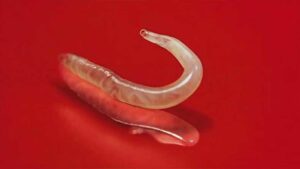
Trichuris: This one is rather located in the large intestines, it measures approximately 2 to 4 cm. It mainly contaminates with its eggs, the environment of dogs that live in the community, and is found in their outside living environment. It attaches to the walls of the intestines to feed on blood which can cause anemia and hemorrhagic colitis which results in a deterioration of the general condition of the animal. Fortunately, it is not a zoonosis and therefore does not contaminate humans.

Effects in humans
Ingestion of roundworm eggs in humans can cause blindness, damage to the nervous system, or damage to internal organs. Hookworm infection can cause skin damage. Some worms can migrate into organs such as the skin, liver, lungs, brain, heart, muscles, and eyes.
Effects in animals
Adult roundworms live in the intestines of our dogs and cats and most of them will not necessarily show symptoms. On the other hand, a more important infection, in puppies and kittens, could bring the following symptoms:
- Dull coat.
- Round belly.
- Weight loss and stunted growth.
- Digestive disorders (vomiting, diarrhea).
- Bronchitis and cough when roundworms migrate through the lungs.
How are humans infected?
Depending on the different types of roundworms, humans can contract these parasites in different ways. It is not uncommon to see them infecting children, either through the ingestion of eggs microscopically present in their environment, but some may also cross the transcutaneous barrier. Humans will contract them mainly in the garden, in the sandbox, in forests or fields, or even by eating poorly washed food.
Prevention
To prevent human contamination, it is essential to respect certain basic hygiene measures, in particular, hand washing frequently to avoid oral contamination.
Secondly, it is important to deworm your animal regularly throughout its life; the frequency depends on the way of life of our animal, and the parasitic pressure of its environment.
Bacteria (leptospirosis, chlamydia, campylobacteriosis, salmonellosis)
Leptospirosis
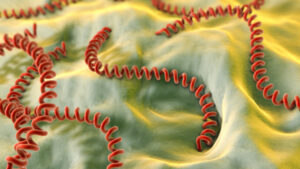
is a disease caused by a bacterium (Leptospira interrogans) which can survive for several years in a hot, humid and shaded environment. Water is an essential element for the survival of this bacterium in the environment.
Effects in humans
- Period before symptoms: 1 to 2 weeks.
- In 80 to 95% of cases: fever, chills, headache, muscle pain and fatigue.
- In 10 to 15% of cases: jaundice is caused by disorders of the liver, kidneys and blood.
- Duration of illness: healing takes a few days to a few months.
Effects on dogs
- Acute renal impairment and hemorrhagic gastroenteritis.
- Infected animals that do not show symptoms can transmit the disease to humans.
How are humans infected?
- Through the skin, mucous membranes of the nose, mouth, and eyes (e.g.: by bathing in a contaminated stream).
- Through direct or indirect contact with the urine of infected domestic animals (cattle, pigs, dogs, and horses) or wild animals (mice, rats, raccoons and skunks) or with placental or fetal tissue from abortions.
- The environment, if it is contaminated with the urine of animals (e.g.: pastures and streams).
Prevention
- Vaccination: vaccination is possible in dogs, cattle, and pigs, but not in horses. It does not prevent infection but reduces the likelihood and duration.
- Observe good personal hygiene measures, mainly washing hands after each handling.
- Avoid drinking, eating, or smoking while taking care of animals (e.g.: during grooming or cage maintenance).
- Strictly observe the vaccination protocol recommended by your veterinarian.
- Wear protective gloves and clothing when caring for animals.
- Avoid letting dogs drink or walk-in pools of water to which wildlife has access (e.g.: in public parks).
- Control pests and do not allow dogs to approach wildlife.
- Avoid swimming in potentially contaminated ponds.
- Fence the vegetable gardens to prevent animals from accessing them.
- Avoid coming into contact with the urine of infected or suspected animals, whether sick or recovering.
Chlamydia
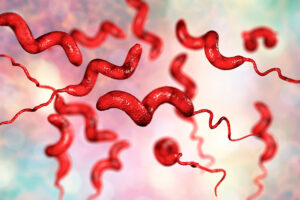
is a disease caused by a bacterium (Chlamydia felis).
In general, Chlamydia strains can survive from a few weeks to several months in the environment.
Effects in humans
- Symptom: Conjunctivitis.
- Rarely transmitted to humans.
Effects in animals
- Symptoms in cats: fever, mild rhinitis, sneezing or severe conjunctivitis.
How are humans infected?
- By direct contact with infected cats. These cases are rare.
Campylobacteriosis (Campylobacter spp., C. jejuni, C. coli, C. lari) is a disease caused by a bacterium that is widespread worldwide. It is one of the bacteria most frequently involved in food infections. It can survive in water for a month at a temperature of 4°C and does not resist heat.
Effects in humans
- Incubation period: 2 to 5 days, on average.
- Symptoms: severe abdominal pain, nausea and vomiting, fever, blood in the stool, diarrhea, headache, muscle, or joint pain,
- Duration of illness: healing usually takes 7-10 days.
Effects in animals
- Infected animals are generally carriers but have no symptoms. They can, however, excrete the bacteria found in their intestines and thus, constitute a source of infection for humans. Severe diarrhea can occur, especially in young animals.
How are humans infected?
- By consuming contaminated water or food:
- Unpasteurized milk or by-products.
- Meat that is not sufficiently cooked (chickens, pork, etc.).
- Contaminated food during preparation (e.g.: use of the same utensils for raw and cooked products).
- Untreated water (streams, wells, lakes, etc.).
- By direct contact with an infected animal:
- Young animals such as calves, kittens, or puppies, especially if they have diarrhea.
- Birds, both domestic (e.g.: hens, turkeys) and wild (e.g.: pigeons, gulls) carrying the bacteria.
- Animals that have had an abortion (sheep, goats), because the bacteria can be found in the placenta and amniotic fluid.
- From person to person:
- Infected person (a person can be contagious for a few weeks and even a few months).
- Diaper change in a baby infected with the Campylobacter bacteria.
Prevention
- Wash hands with soap and water after using the toilet and after contact with a person, animal, or possibly contaminated substance (e.g.: baby diapers, animal stools, litter, food, kitchen utensils).
- Refrigerate meats as soon as possible after purchase.
- Cook meats properly, especially poultry. Be careful not to contaminate the meat after cooking. Wash hands thoroughly before touching food and utensils.
- Avoid consuming unpasteurized milk or milk by-products from establishments that do not have a dairy processing permit.
- Refrain from drinking untreated water and check well water regularly. If in doubt, boil the water for at least one minute before consuming it.
- Prevent animals from drinking in the toilet.
- Avoid feeding pets with raw meat.
- Collect animal stool regularly.
- Consult a veterinarian if an animal shows signs of disease.
- The bacterium responsible for campylobacteriosis is sensitive to several disinfectants, including 1% bleach and 70% ethanol.
Salmonellosis
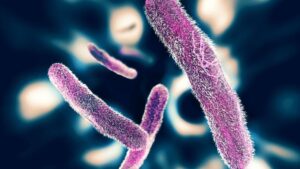
is a disease caused by a bacteria (Salmonella) of which there are more than 2,000 types. It is widespread all over the world and can survive for several months in soil, water, and excrement. It causes one of the most common zoonoses.
Effects in humans
- Period before symptoms: 6 to 72 hours.
- Symptoms: diarrhea, abdominal cramps, fever, headache, and nausea or vomiting.
- Pregnant women, young children, and the elderly or those with weakened immune systems: clinical signs may be complicated and include severe dehydration or generalized infection of the blood.
- Duration of illness: 2 to 7 days.
Effects in animals
- Most of the time, the infection is symptom-free. When there are, they take the following form:
- Cattle: fever, diarrhea with blood, colic, abortion, and pneumonia in newborn calves.
- Sheep and goats: abortion and diarrhea.
- Pigs: fever, diarrhea, and pneumonia (especially in those aged 2 to 4 months).
- Poultry: diarrhea (especially in young animals)
- Dogs and cats: fever, weakness, anorexia, sometimes diarrhea and vomiting.
- Reptiles and aquarium fish: when they are carriers, they generally do not show symptoms.
- Infected animals that do not show symptoms can transmit the disease to humans.
How are humans infected?
By ingestion of contaminated water or food:
- Consumption of meat that is not sufficiently cooked (chicken, pork, etc.); chicken and other poultry carcasses are often contaminated.
- Ingestion of contaminated food during preparation (e.g.: use of the same utensils for raw and cooked products).
- Ingestion of unpasteurized milk or by-products or untreated water (wells, lakes, etc.).
Person to person:
- Diaper change in a baby with salmonellosis.
- Contamination by an infected person (e.g.: through improperly washed hands). Some people who carry the bacteria have no symptoms but can still transmit the disease. This carrier state can last from several weeks to several months.
By direct contact with an infected animal:
- Contact with infected animals, often turtles, reptiles (lizards, snakes), ornamental fish in the aquarium, hedgehogs, or chicks.
- The bacteria can be found in wild birds (e.g.: on feeders).
- Pets fed a diet of raw meats are more at risk of carrying salmonella.
Prevention
- Wash hands with soap and water after using the toilet and after contact with a possibly contaminated person, animal, or substance.
- Respect the precautions to prevent food poisoning.
- Clean and sanitize surfaces and equipment that may have been in contact with the bacteria. A solution of sodium hypochlorite (bleach) can be used (dilute 5 millimetres in 1 litre of water).
- Avoid consuming unpasteurized milk or milk by-products from establishments that do not have a dairy processing permit.
- Refrain from drinking untreated water and check well water regularly. If in doubt, boil the water for at least one minute before consuming it.
- Prevent animals from drinking in the toilet.
- Avoid feeding pets with raw meat.
- Collect animal stool regularly.
- Consult a veterinarian if an animal shows signs of disease.
Microchip
DID YOU KNOW …
- One in three animals is lost at least once in their life.
- The microchip is the best way to identify your pet.
- The microchip inserted under the animal’s skin is no larger than a grain of rice.
- Some municipalities require microchipping of animals registered in their region.
- A microchip can be inserted regardless of the age of your animal.
The microchip is a hypoallergenic electronic device the size of a grain of rice. It is inserted under the animal’s skin between the shoulder blades without discomfort for the latter. This chip contains a unique identification number which allows the registration of the owner’s contact details. This information is linked to an electronic database so that owners can be contacted to find the animal more quickly in the event of loss, running away or theft.
The microchip can be implanted regardless of the age of the animal. In addition, updating the registration details is free.
Why chooses to microchip your animal
When an animal is brought to a shelter or a veterinary clinic, it is scanned with a universal reader which allows reading the identification number. From this number, the authorized services (police, municipal animal services, veterinary surgeons, pound) can consult the database and contact the owner. It is therefore important to update your information, especially during a move.
Microchips comply with all international standards and can be read worldwide. Microchipped pets are 20 times more likely to find their owner quickly. In addition, some municipalities require that the animal be sterilized and microchipped before registration.
For more information, don’t hesitate to call us and a member of the Passion Compassion Veterinary Hospital team will be happy to help you.
Once microchipped, your pet is protected 24 hours a day, 7 days a week, 365 days a year.
The microchip provides permanent identification, unlike the necklace which can come off or the medal which can become illegible.
Disease prevention and treatment
DID YOU KNOW …
- There are 4 kinds of ticks in Canada.
- Tick bites can transmit many diseases to both humans and animals.
-
Lyme disease is caused by a tick bite infected by a bacteria called Borrelia burgdorferi.
TicksTicks are becoming more common in Canada.
They are not present in winter; however, these detestable critters return as soon as temperatures reach 4°C
and the ground is no longer completely covered with snow.There are four kinds:
- Deer tick
- American dog tick
- American star tick
- Blood tick
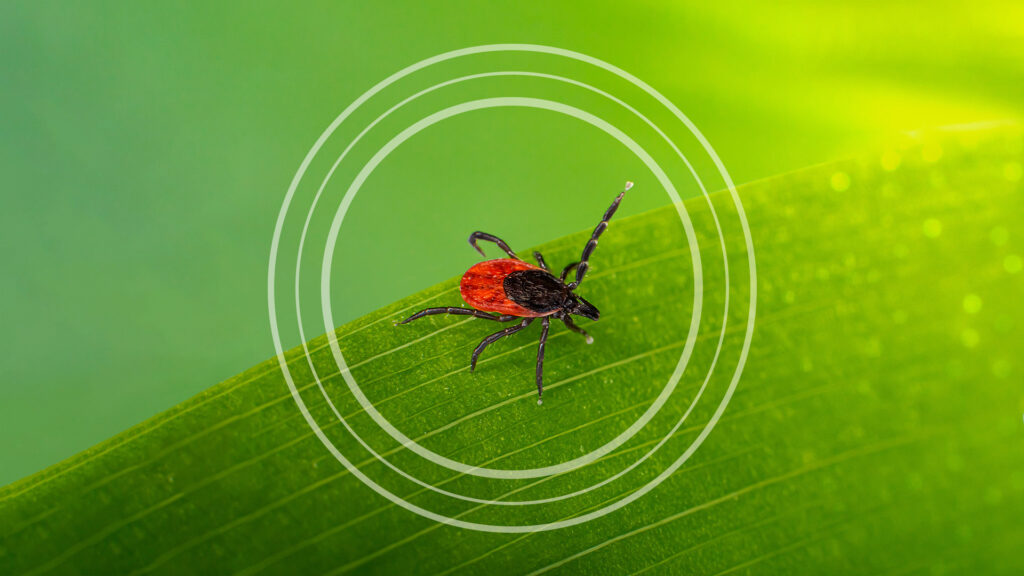
The region’s most at risk in Quebec are: Montérégie, Mauricie, Center of Québec, Townships and Outaouais.

A single tick bite can infect your pet, and they are a source of transmission for many diseases to animals and humans, including these:
Lyme disease: Tissue infection that can lead to lameness. Symptoms: lameness, prostration, fatigue.
Ehrlichiosis: Infection of white blood cells, which can affect the function of the bone marrow. Symptoms: depression, loss of appetite, bleeding, joint pain.
Anaplasmosis: Blood infection that can lead to bleeding disorders. Symptoms: loss of appetite, lethargy, lameness.
Rocky Mountain spotted fever: Infection causing a sudden serious illness that without treatment can be fatal. Symptoms: joint stiffness, neurological abnormalities, fever.
Prevention for dogs
The ideal option is a tick repellent (K9 AdvantixÓ), a topical product that kills the tick on contact with the dog. There are also oral products, such as SpectraÓ, NexgardÓ, BravectoÓ, and SimparicaÓthat kill ticks before it can transmit disease. Avoid the undergrowth, long grass, and cedar hedges, stay on the trails. Inspect your pet when he returns home when he visits risky areas.
If you find one or more ticks, quickly remove them with a tick hook.
Prevention for humans
Wear light, long-sleeved clothes to see ticks and tie the hair. Do a body check after going to a risky place. Apply insect repellent containing DEET or icaridin.
Lyme disease
In Quebec, the black-legged tick (Ixodes scapularis, or deer tick) can transmit this disease. Populations of this tick species are established in southern Quebec. The risk of infection is increasing for both animals and humans.
Effects in humans
Period before the onset of symptoms: 3 to 30 days.
Symptoms: because of an infected tick bite, redness of more than 5 cm can develop in 60 to 80% of cases. The redness usually takes the form of a target, a hallmark of the disease. Fever, fatigue, headache, stiff neck, or muscle pain may also be felt. Sometimes the disease progresses to a more serious form, which can cause arthritis or serious neurological or heart problems.
Duration of illness: a few days, or even years if left untreated and progresses to more serious manifestations.
Effects in animals
Most often, infected animals show no signs of disease. If there are signs, their severity varies and is revealed in different ways depending on the species. Generally, there is fever, fatigue, loss of appetite, lack of energy, swollen glands and lameness caused by joint pain. These pains can affect each of the legs in turn. The redness that can spread around the bite of an infected tick is rarely seen on the hairy skin of animals.
Dogs: Only 5-10% of infected dogs will show signs of illness, occurring 2-5 months after being bitten by an infected tick. The signs will usually go away on their own in less than a week. Sometimes they reappear cyclically. If the disease is not treated quickly, it could cause heart, nervous or kidney problems that are often fatal.
Horses, donkeys, and mules: in addition to the signs generally observed, behavioural changes and other nervous signs may occur, as well as eye problems in some horses.
How are animals and humans infected?
In Quebec, only the bite of an infected black-legged tick (Ixodes scapularis, or deer tick) can transmit Lyme disease. However, the risk is slow if the tick remains attached to the skin for less than 24 hours. It increases if the tick stays on it longer.
The tick does not jump and does not fly. Rather, it remains to wait, usually in tall grass or bushes, until an animal or human pass by. If, before feeding, its size can vary between 1 and 3 millimetres, the tick can triple in volume when it is engorged with blood. It needs to feed on the blood of an animal or a human at each stage of its development (larva, nymph, and adult).
The disease does not spread from an infected animal to humans, nor from contact between two people. On the other hand, when a black-legged tick is found on an animal, it suggests that there are other specimens of the species in the immediate environment or that there were some in a recently visited place. The owners of the animal are therefore also likely to have been in contact with the ticks responsible for the transmission of the disease.
Prevention
Ticks are very small mites. Their bites easily go unnoticed. Blacklegged ticks that can transmit Lyme disease can be active from 4°C. They reach their optimal activity level at around 25°C. The risk of stinging is present especially in spring and summer, but it persists until fall. During this period, it is important to protect yourself.
The best way to avoid catching the disease is to prevent tick bites. If you practice activities in the forest, woods, or tall grass, it is advisable to wear:
- Closed shoes and a hat.
- Pants whose ends are inserted into the socks.
- A long-sleeved sweater inserted into the pants.
In addition, applying a DEET or icaridine repellent will help keep ticks away. A veterinary surgeon can advise you on the products offered to protect animals. Other actions help reduce the presence of ticks in the immediate environment, for example:
- Regular maintenance of the land and buildings to limit the presence of rodents (often carriers of the bacteria and responsible for the infection of immature ticks).
- Installation of a fence to keep white-tailed deer at a distance (as an adult, the black-legged tick prefers these animals to complete its maturation and reproduce).
- Maintenance of vegetation to clear the perimeter of the house and play areas.
After a risky activity
- Within 2 hours of outdoor activity, check if a tick is on your body or on your children, ideally by taking a bath or shower. Check on your pet, using a brush. To avoid introducing a tick into your home, examine your equipment and put your clothes in the dryer for at least 10 minutes on high heat.
- If you spot a tick, remove it with fine-tipped pliers (e.g.: tweezers), without compressing its abdomen. If the head of the tick remains implanted in the skin, you can gently remove it with forceps. If you are unable to remove it, leave the head of the tick in place and wait for the skin to heal, as this part can no longer transmit Lyme disease.
- Store the tick in an airtight container placed in the refrigerator (4°C). Note the location of the bite, then the date and location of your recent outdoor activities. The tick and this information will be helpful if you need to see a doctor or veterinarian.
- If you have been bitten by a tick, contact Info-Santé 811 to determine
whether it is necessary to consult a health care professional for preventive treatment. - Otherwise, watch for signs consistent with the disease. If you have symptoms, see a doctor quickly.
If your pet shows signs of illness, contact a veterinarian. A consultation will determine if antibiotic treatment is indicated.
Surveillance
In Quebec, a surveillance system for Lyme disease and other tick-borne diseases is in place. Surveillance has isolated a few regions in southern Quebec where the risk of disease transmission is greater. It reveals that the proportion of ticks infected varies and is generally low, rarely exceeding 20%.
Human cases of Lyme disease are among the reportable diseases. An analysis of ticks found on humans and, in some regions of Quebec, on animals and in the environment, is also done. It makes it possible to determine the progression of ticks in the areas where they are established as well as the percentage of ticks carrying the bacteria causing the disease. It is thus possible to better assess the risks for the Quebec population.
The Quebec Public Health Laboratory of the National Institute of Public Health of Quebec (INSPQ) receives ticks from hospitals and medical and veterinary clinics. They identify tick species and route black-legged ones to the National Microbiology Laboratory in Winnipeg for analysis.
Dental Care
DID YOU KNOW …
- Dental disease affects about 85% of cats and dogs over the age of one.
- A cat can suffer from periodontal disease without showing obvious signs.
- Periodontal disease can lead to heart and kidney disease.
- The time and effort you put into brushing your pet’s teeth can significantly improve their quality of life.
Dental care plays a key role in your pet’s health. As in humans, some animals have a genetic predisposition and will suffer from dental diseases at a younger age or will be afflicted with more serious dental conditions.
Untreated dental disease can lead to gum recession, loose teeth, inflammation, gum bleeding, oral infections, and even tooth loss. In addition, if the bacteria responsible for the disease are found in the bloodstream, they can attack the lungs, kidneys, heart, liver and nervous system of the animal.
Oral care reduces the discomfort and medical problems that accompany periodontal disease such as:
- Bad breath (halitosis)
- Inflammation of the gums (red and swollen)
- Pain
- Salivation, difficulty chewing, loss of appetite (anorexia)
- Loss of weight and muscle mass
- Inactivity, reduced interaction with family
- Bacterial infection of the heart, liver and / or kidneys.
The oral care you give your pet every day, as well as the routine dental checkups your veterinary team performs, will improve the quality of life for your four-legged love.
Your Passion Compassion Veterinary Hospital team will be happy to help you establish a comprehensive dental care plan for your pet that may include:
- A dental cleaning to remove the accumulation of tartar and plaque.
- The extraction of any unhealthy tooth.
- Regular dental exams.
- Instructions on how to brush your pet’s teeth at home.
Solutions at your fingertips
Nutrition
Veterinary-exclusive dental formulas combine a tailor-made kibble and the addition of ingredients that reduce tartar and plaque formation. These formulas encourage a urinary environment that is unfavorable for the formation of crystals and stones of struvite and calcium oxalate, which reduces the risk of stones in the bladder.
When prescribing this type of food for your pet, keep in mind that it may be necessary to allow a transition period of 5 to 7 days to get used to the new formula. During this period, you should gradually integrate the new formula with the old one.
Mouth care products
There is a range of scientifically formulated oral health products for dogs and cats including toothpaste, water additive and dental spray. These products, specially designed for animals, help fight plaque and tartar and freshen the breath. Consult our specialist to find out more.
Sterilisation
DID YOU KNOW …
- The sterilization of an animal is generally carried out around the age of six months.
- Sterilization is done under general anesthesia.
- It reduces the risk of mammary gland cancer for the female and perianal tumor and prostate cancer for the dog.
- It also reduces the risk of running away.
- In less than four years, a single pair of cats can breed more than 20,000 cats.
Each year in Quebec, tens of thousands of cats and dogs are born, cannot find a home and must be euthanized. Sterilization is part of the solution.
Sterilization is generally carried out around the age of six months but could be anticipated or delayed by the veterinarian depending on the breed or medical condition. It is done under general anesthesia.
For the cat and the dog, it is an ovario-hysterectomy. This involves making an incision on the abdomen to remove the ovaries as well as the uterus. For males, this is castration, the removal of the testicles. However, we leave the scrotum, but it will be empty. The prostate and penis remain intact, they are not removed.
Advantages
… from a medical point of view
Sterilization decreases the risk of pyometra, an infection of the uterus which can, if not treated quickly, lead to sepsis and possibly death. It is also more expensive surgery than having an ovario-hysterectomy.
It reduces the risk of cancer of the mammary glands for the female. If sterilization is carried out before the first heat, it avoids 99% the risk of having cancer of the mammary glands. After the third heat, the animal is 75% more likely to get this cancer. In 25% of cases, we note that cancer will be malignant for 9 out of 10 cats. For bitches, 1 in 2 will develop malignant cancer.
For dogs, there is a reduction in the risk of perianal tumors as well as diseases, infections, and prostate cancer.
… for dogs’ behavior
A female dog has heat accompanied by heavy bleeding twice a year. Sterilization decreases excessive licking and eliminates unsightly traces on the fabrics of the house.
As in cats, sterilization in dogs reduces the risk of running away and therefore accidents caused by cars.
… for cats’ behavior
Castration of the male decreases the strong odors of urine and the urinary marking, the battles between tomcats and the veterinary costs which ensue, as well as the propagation of AIDS and feline leukemia as well as the runaways of the males who feel the need to go and conquer the female at all hours of the day and night.
In females, ovario-hysterectomy reduces the risk of running away. Like the male runs away to find his sweetheart, the female also wants to run away to find his Romeo!
According to some studies, sterilization increases the grooming behavior of the cat. So, you will have a cleaner cat.
And most of all…
Pussies in heat which vocalize the day and especially the night, can prevent you, as well as all the neighborhood from enjoying a quiet and restful sleep.
Each sterilized feline can greatly reduce the overcrowding that is found in shelters and too often euthanized for lack of space.
TRUE OR FALSE
- A cat or a dog must be allowed to have a first heat before being sterilized.
True____ False____
- Not being able to reproduce has no impact on animal welfare and balance.
True ____ False ____
- My dog will be more guardian if he is not neutered.
True____ False____
Answers :
- In fact, it is quite the opposite because sterilization performed before the first heat reduces the risk of cancer in the mammary glands by 99%
- The animal will not be unhappy with this situation. On the contrary, it will not be frustrated to have hormones that push it to reproduce while being denied the right to access it.
- The sexual instinct and the property instinct are two things. A neutered dog is as good a guard as an intact dog.
If you hesitate to sterilize your pet or if you have questions about the anesthesia or the risks related to this procedure, do not hesitate to discuss it with the staff of Passion Compassion Veterinary Hospital.
And if you have planned to breed your pet…
Make sure to check if the animal has a genetic disease that it could pass on to future generations. Set aside a budget to cover the costs of ultrasound to check the number and viability of fetuses and those of dystocia (problem with childbirth). Costs may be incurred for the veterinarian’s intervention or for a cesarean (performed under general anesthesia).
Recommended examinations during anesthesia
- Examinations of the oral cavity, elbows, and knees – …
- X-Ray of the hips – Used to detect hip dysplasia, this X-ray is recommended for medium or large dogs. Ideally, we take this X-ray at the time of sterilization because the animal is under anesthesia, it then allows a perfect anatomical position for a precise evaluation. The sooner this examination is done, the more it will be possible, in the event of an anomaly, to consider means to prevent too rapid deterioration of hip health.
Diagnostic Tests
DID YOU KNOW …
- More than 60% of puppies and kittens have intestinal parasites transmitted
by the mother or their contaminated environment. - A parasitic infestation will harm the growth and general health of the animal.
- Some intestinal parasites can contaminate your land for
several years and cause your animal to re-infest. - Dog parks are the most contaminated places.
- Several intestinal parasites are transmissible
from animals to humans (zoonoses). Stool analysis (coprology)
Your pet is at risk of infestation in the following cases: - He was born to an infected mother.
- Its environment is frequented by other
animals infected by parasites (e.g.: stray animals, foxes, coyotes). - Your pet eats prey or raw meat.
- Your pet is infested with fleas.
- It is recommended to do a coprology:
- On the first visit of your animal, whether young or adult.
- Once a year all animals go outside.
- Twice a year for all those eating a raw diet.
- After medical treatment against intestinal parasites.
Pre-anesthetic blood tests
To make sure your pet can receive and dispose of an anesthetic,
we do tests to confirm that their organs are working well and to find hidden
conditions that could endanger your pet’s life.
Main reasons for performing analyses before anesthesia
- Get peace of mind
Examinations can significantly reduce the risk of anesthetics and surgery.
- Detect hidden conditions
Animals that appear healthy may hide signs of illness.
Analyzes help detect these diseases and help avoid problems during anesthesia.
- Reduce risks and consequences
When the pre-anesthetic results are not normal, we can modify the anesthetic technique
or take other precautions to preserve the health of your animal.
- Protect your pet’s health in the long term
The results of the analyzes are entered in your animal’s medical file and will be used for later use.
To be able to safely practise anesthesia for your pet, we perform the following analyzes:
Although it is not mandatory, it is also highly recommended to install an intravenous catheter during an operation.
Intravenous fluids during anesthesia help stabilize blood pressure and kidney function.
In addition, the catheter provides direct access to a vein in an emergency for rapid drug delivery.
Detection blood and urine tests (disease screening)
To determine the health status of your animal, we carry out certain screening tests.
Internal organs
To detect the following conditions:
- Liver disease
- Cushing’s syndrome
- Certain cancer
- Dehydration
- Obstruction of bile ducts
- Abnormalities following long-term medication
Teeth
To update abnormal teeth and soft tissue in the mouth in dogs, and in cats,
infections of vital organs secondary to oral disease, feline AIDS, feline leukemia virus, herpesvirus and calicivirus.
Thyroid
Biochemical examinations and the serum determination of free T4, total Ta and TSH can detect thyroid disease.
Heart and lungs
To detect heartworm disease, or heartworm, and heart disease
Blood
To screen for the following conditions:
- Anemia (lack of red blood cells)
- Inflammation
- Infection
- Stress
- Leukemia
- Bleeding
- Inability to fight infection
- Hydration status
- Some infectious agents
- Lyme disease
- Ehrlichiosis
- Anaplasmosis
Kidneys
To screen for the following conditions:
- Recent kidney disease
- Primary kidney disease
- Renal failure
- Infection
- Kidney stones
- Cancer
- Abnormalities following long-term medication
The urine analysis and the protein/creatine urine ratio are used to better assess the following points:
- Kidney function
- Urinary tract infection
- Kidney infection
Pancreas and intestine
To screen:
- Pancreatitis (inflammation of the pancreas)
- Diabetes mellitus
- Abnormalities following long-term medication
- Cancer
Egg and fecal parasite tests and diarrhea checkups can identify
parasites, bacteria and/or viruses that can cause:
- Diarrhea
- Weight loss
- Blood loss
- Infections in humans (zoonosis).
Aids test and feline leukemia
DID YOU KNOW …
- Feline AIDS virus (FIV) and feline leukemia virus (FeLV) are major causes of death and disease in cats.
- There is no cure to stop these two viruses.
- These two viruses weaken the immune system and increase the risk of developing dental, eye and blood diseases or malignant tumors (lymphomas).
- Detecting the infection early helps keep your cat healthy but also prevents transmission of the infection to other cats.
- There is a feline leukemia vaccine that is highly effective (98%) in preventing infection.
The FIV virus and the FeLV virus are transmitted through contaminated blood. However, the FeLV virus can also be transmitted through saliva, nasal secretions, urine and stool. For example, sharing a bowl of water or food can be a source of infection, as can litter.
Some cats show no signs at the start of the infection, but their health deteriorates gradually over the weeks, months or years that follow. Many cats have nonspecific symptoms, such as dull coat, weakness or infections of the skin, respiratory tract, or eyes. Common signs include the following:
- Fever
- Decreased appetite
- Weight loss
- Diarrhea
- Swollen glands
- Pallor or inflammation of the gums.
It is recommended that the test be taken at:
- Any cat (young or adult) newly acquired and at least once in its life.
- Any kitten born from a stray cat from a cat unknown VIF / FeLV status.
- Any new cat brought into a household where other cat lives.
- A cat that may have contact with other infected cats (cats going outside, cats in boarding).
- A cat with bites or battle scores.
- A sick cat that has never been tested.
Vaccination
DID YOU KNOW…
- Rabies is almost always fatal after the onset of symptoms,
in both animals and humans. - The risk in children is about 4 times higher than in adults.
- Skunk, foxes, bats and raccoons are common carriers of the rabies virus.
- In humans and animals, rabies progresses from paralysis to coma, then death.
Rabies
Rabies is a viral disease that affects domestic and wild animals and can be transmitted to humans. It is typically spread through contact with the saliva of an infected animal – through a bite, scratch, or lick of a lesion on the skin or mucous membranes such as that of the mouth, nose or eyes.
Rabies can be 100% prevented through a good awareness and vaccination program. Ask your veterinarian at Passion Compassion Hospital about your pet’s vaccination against rabies today. Vaccinating your pet helps protect your whole family.
Feline diseases:
Feline panleukopenia
Feline panleukopenia is caused by a highly resistant parvovirus in the environment. This virus is different from the virus responsible for canine parvovirus. Unvaccinated kittens are the most exposed to the disease. The virus multiplies in the digestive tract and bone marrow, which explains the symptoms observed. It is a highly contagious virus that is excreted in stool and body fluids. Among the signs observed, we can see vomiting and often bloody diarrhea, fever, reluctance to eat and a state of extreme physical depression, weakness, and total inactivity. These signs can quickly lead to dehydration and anemia in the animal. The number of white blood cells is often very low. It is very resistant to the environment in which it can survive up to a year. Therefore, the infection can be contracted through direct contact with the stool of infected cats, or indirectly, through exposure to a contaminated environment or object, such as the cat’s « bed » or its bowl, or through contact with people who have touched an infected animal. The infection is spread by ingestion of the virus.
Leukemia
Feline leukemia is one of the most important causes of illness and death in cats. It causes lymphoma, which is a form of cancer in about 15% of infected cats, and as it suppresses the immune system and cell production by the bone marrow, it is also responsible for other infectious diseases. One of the important sources of the spread of feline leukemia is the transmission of the disease from cats whose infection persists despite appearing to be in good health. Feline leukemia is spread by simple contact with the body fluids of an infected animal. Leukemia can be transmitted through the urine when more than one cat uses the same litter box, bowl, or bowl of water. It is also transmitted by a bite, mutual grooming between cats and even by breast milk when the infected cat breastfeeds its kittens. The virus does not infect humans or other pets other than cats. The most common signs of the disease are fever and lethargy, loss of appetite, gradual loss of weight, dull coat, enlarged lymph nodes, anemia in about 25% of cats, infection of the skin or upper respiratory tract and gastrointestinal signs such as diarrhea and vomiting. In the fight against disease, vaccination is the most effective way to strengthen the immune system of your pet. Vaccines prepare the body for the pathogens it will encounter and help the immune system mount its own defence system against them – many of which can be fatal.
Feline infectious rhinotracheitis
Rhinotracheitis is an infection caused by the presence of a virus that affects the upper respiratory tract. In some cases, a secondary bacterial infection may develop. This virus is like the flu in humans, but it does not spread from cats to humans and vice versa. Symptoms are often nasal congestion and a clear runny nose. Redness and inflammation in the eyes are often noted. Some cases will be limited as well. On the other hand, other animals will have a bacterial superinfection so the nasal and ocular secretions will become thick and yellowish to greenish. In these cases, cats often have a loss of appetite caused by fever and they are amorphous. The infection can cause pneumonia in cases where it is not treated.
The calicivirus
Calicivirosis is a viral disease caused by a calicivirus. Caliciviruses are very contagious. Transmission takes place by direct or indirect contact, for example, clothing and shoes or by equipment. The virus is mainly excreted in the nasal, oral and ocular secretions of symptomatic and asymptomatic cats. Symptoms vary depending on the strain of the virus. One can observe an inflammation of the mucous membrane of the nostril, fever, pneumonia and more generally chronic gingivostomatitis characterized by painful, erythematous and swollen gums with very painful mouth ulcers. There is also a hypervirulent form of caliciviruses characterized by a significant fever, edema of the face and limbs and ulcers of the skin and on the pads.
Canine diseases:
Parvovirus
This disease is caused by a parvovirus. The virus multiplies in the digestive tract and bone marrow, which explains the symptoms. These are mainly characterized by severe vomiting and bloody diarrhea. The dog is also often seriously ill, has a fever, is weak and is reluctant to eat. This condition can lead to dehydration and blood tests can reveal certain abnormalities such as a decrease in the number of white types of blood cells. It is a highly contagious virus that is excreted in stool and body fluids. It is very resistant to the environment in which it can survive up to a year. Therefore, the infection can be contracted through direct contact with the stool of infected dogs, or indirectly, through exposure to a contaminated environment or object, such as the dog’s « bed » or its bowl, or through contact with people who have touched infected animals.
Square disease
Distemper is a highly contagious disease. It affects dogs and is still a very dreaded disease today. Nowadays, epidemics are rare thanks to mass vaccination, but it still happens that dogs (from individuals or from shelters) succumb to this difficult disease the animal and are often fatal. It is easily spread by direct contact with sick dogs. It is present in the discharge from the nose and eyes which easily transform into aerosol droplets. An infected dog can shed the virus for months. Even if the virus is relatively unstable outside the host, it can be transported over a certain distance via a person’s clothes and infect unprotected dogs coming into contact. The spread of the virus is very rapid in communities, especially in shelters and dog shows, hence the obligation to vaccinate dogs frequenting or participating in this type of event.
Leptospirosis
This disease is caused by Leptospira, a bacterium widely spread around the world. Transmission is usually through the infected urine of a carrier animal, eliminated through a puddle of standing water. The bacteria then enter the body from a skin wound or by ingestion of contaminated water. Symptoms are high fever, vomiting, diarrhea that may present with blood, jaundice, severe dehydration, lethargy and risk of death. Dogs can also pass Leptospira to humans and other dogs through the urine. After being infected, many dogs become long-term carriers when they appear to be in perfect health. Without strict hygiene measures, families and their dogs can be at risk of serious illness. The disease can sometimes be fatal for dogs and humans.
Canine infectious hepatitis
Contagious canine hepatitis is a disease that affects dogs; it has nothing to do with hepatitis in humans. It is much less common today because vaccination can effectively prevent the disease. However, this extremely contagious and sometimes fatal disease is still observed in the clinic, especially in unvaccinated puppies. Symptoms are characterized by severe lethargy, abdominal pain, fever, enlarged nodes, vomiting, diarrhea and sometimes seizures. The disease mainly attacks the dog’s livers, but also their dog’s kidneys, spleen, lungs and eyes. Very young puppies die within a few hours and the virus spreads very quickly on a farm. Ingestion of urine, stool or saliva from infected dogs is the main source of infection. Once cured, dogs can excrete the virus in the urine for 6 months. The virus is resistant to many disinfectants and can persist in the environment for weeks or even months.
Canine coronavirus
Canine coronavirus is a contagious viral intestinal disease; it is often diagnosed in puppies. The clinical signs are similar to those of parvovirus and include vomiting, diarrhea and dehydration. Coronavirus infection can be prevented by vaccinating puppies from a young age.
Kennel cough
Kennel cough, or canine cough, is a highly contagious respiratory infection often caused by a bacterium called Bordetella bronchiseptica. Another important cause of this disease is the canine parainfluenza virus. Kennel cough causes severe irritation and inflammation of the trachea and bronchi and can degenerate into pneumonia. In the absence of complications, the disease usually resolves within 1 to 3 weeks. Depending on its severity, however, veterinary care may be necessary. The disease is spread from infected dogs and is particularly common in boarding houses and kennels where many dogs are housed together. Dogs can also get infected in grooming salons, dog daycares and dog parks.

Send us a message

Visit our offices

Call us Today
450-906-6090

Personal information protection
We collect only the information necessary to provide care and products, to administer the care that is provided, and to communicate with you. We do not collect any other information, nor do we allow information to be used for any other purpose, without your consent. For questions concerning this policy, do not hesitate to contact us.

